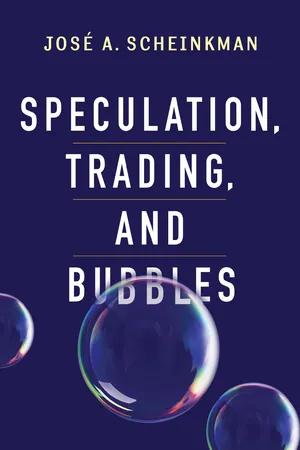
Speculation, Trading, and Bubbles
- English
- ePUB (mobile friendly)
- Available on iOS & Android
Speculation, Trading, and Bubbles
About this book
As long as there have been financial markets, there have been bubbles—those moments in which asset prices inflate far beyond their intrinsic value, often with ruinous results. Yet economists are slow to agree on the underlying forces behind these events. In this book José A. Scheinkman offers new insight into the mystery of bubbles. Noting some general characteristics of bubbles—such as the rise in trading volume and the coincidence between increases in supply and bubble implosions—Scheinkman offers a model, based on differences in beliefs among investors, that explains these observations.
Other top economists also offer their own thoughts on the issue: Sanford J. Grossman and Patrick Bolton expand on Scheinkman's discussion by looking at factors that contribute to bubbles—such as excessive leverage, overconfidence, mania, and panic in speculative markets—and Kenneth J. Arrow and Joseph E. Stiglitz contextualize Scheinkman's findings.
Frequently asked questions
- Essential is ideal for learners and professionals who enjoy exploring a wide range of subjects. Access the Essential Library with 800,000+ trusted titles and best-sellers across business, personal growth, and the humanities. Includes unlimited reading time and Standard Read Aloud voice.
- Complete: Perfect for advanced learners and researchers needing full, unrestricted access. Unlock 1.4M+ books across hundreds of subjects, including academic and specialized titles. The Complete Plan also includes advanced features like Premium Read Aloud and Research Assistant.
Please note we cannot support devices running on iOS 13 and Android 7 or earlier. Learn more about using the app.
Information





Table of contents
- Cover
- Series Page
- Title Page
- Copyright
- Contents
- Foreword
- Acknowledgments
- Introduction
- Speculation, Trading, and Bubbles
- Appendix: A Formal Model
- Commentary
- Commentary
- Commentary
- Discussion
- Notes
- References
- Notes on Contributors
- Index